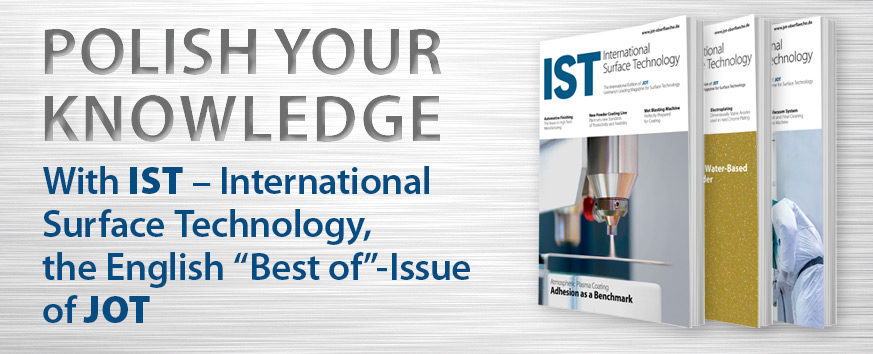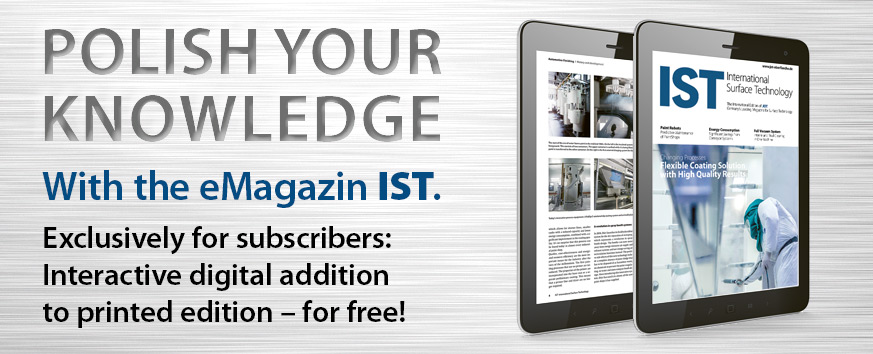The variety of available blasting processes repeatedly presents users with the challenge of finding the optimum solution for their individual application. In recent years, the blasting expert Paul Auer has focused in particular on wet blasting and has continuously developed this process. The initially very simple systems, mainly manual hand-held blasting cabins with a simple container in which abrasive is mixed with water and kept mixed by means of special mixers, are still in use in many companies, but the demand for more complex and fully automatic systems has been steadily increasing for years. This is mainly due to the high and ever-increasing demands on the reproducibility of the blasting results due to increasing quantities and the many advantages compared to dry blasting.
Wet blasting vs. dry blasting
In contrast to dry blasting, where the abrasive and the workpieces must be and remain as dry as possible, wet blasting also allows damp or wet as well as slightly oily workpieces to be processed without any problems. In this process, a specific amount of abrasive is mixed with water. This water-blasting medium mixture is pre-accelerated and transported to a blasting nozzle, where it is normally additionally pressurised with compressed air. The resulting spray jet is directed onto the surface to be treated and the abrasive contained in the water interacts with it to create a corresponding surface. The homogeneity of the water-blasting medium mixture ensures an equally homogenous and consistent surface quality. By precisely regulating the quantity and pressure, the blasting result can be adjusted with correspondingly fine abrasive even in the micrometre range.
By adding corrosion protection or others, the properties of the surface can be adapted to individual requirements and subsequent production steps and thus improved. The risk of abrasive entrapment in the surface that occurs with dry blasting, especially with softer metals, is significantly reduced by using wet blasting. In addition, wet blasting does not require any additional extraction in the form of dust removal (dust extraction), as the abrasive is immediately bound in the water and the formation of dust is thus almost completely avoided.
Depending on the abrasive and grain size used, much smoother surfaces can be produced than with dry blasting. Classic blasting media for wet blasting are corundum, i.e. aluminium oxide, in the qualities "brown", "white" or "pink". But glass beads or ceramic beads as well as various granulates made of plastic are also used very frequently. Compared to dry blasting, the abrasive consumption is significantly lower and the impact of the individual abrasive grains is dampened by the surrounding water.
Change the blasting agent-water mixture regularly
A special requirement and at the same time a challenge in wet blasting is the preparation of the abrasive-water mixture. In contrast to dry blasting systems, where grain that is too fine can simply be extracted and grain or impurities that are too coarse can be sieved out, in wet blasting everything initially remains in the water bath. Since enrichment cannot be prevented, the entire abrasive-water mixture must be completely replaced after a certain time (service life) in many systems. The change interval must always be adapted to the respective application and may be required monthly or even much more frequently. Regular checks of the mixture and an equally regular check of the blasting results are decisive for this change.
When wet blasting with a fully automatic system, the workpiece is placed in the workpiece carrier manually or by robot. The individual carriers are designed in such a way that they automatically run through the blasting process in an optimal way and ensure a perfect blasting result. The individual blasting process runs according to the parameters of the individual blasting programme stored in the PLC control. During the entire process, rinsing water can be generated if required, with which the respective workpiece can be rinsed in a separate rinsing chamber of the automatic blasting machine and thus pre-cleaned for subsequent processes. An additional blow-off process can take place in another chamber, which dries the component and thus further improves component cleanliness. The workpiece can then be removed. All automatic processes take place in parallel as far as possible and are time-optimised.
The complete article was published in the German anniversary issue of JOT.
Autor(en): Paul Auer GmbH




